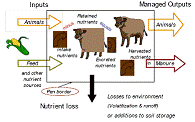Biological Systems Engineering
Date of this Version
2003
Abstract
The feasibility of anaerobic digesters for dairy and swine operations in Nebraska was evaluated using EPA’s Ag Star software program Farmworks 2.0 (1997) and local values for farm energy costs, mainly electricity. Four incentive programs were considered that would subsidize anaerobic digestion. Installation of a digester system is a significant investment that is currently very difficult to justify economically to Nebraska producers based upon consideration of readily quantifiable income and expenses, regardless of farm size. Larger dairy operations looking to invest in this technology would benefit most from a tax credit and/or subsidized electricity sales, policies that relate directly to the production of electricity. On the other hand, small dairy farms likely would benefit more from a no-interest loan or a cost-share program – policies that relate directly to the capital cost incurred. Larger operations are more likely to place a value on odor control and would experience a lower unitized effective cost than smaller operations. The effective cost may still be unwieldy in an industry with tight profit margins, however.


Comments
Written for presentation at the 2003 ASAE Annual International Meeting Sponsored by ASAE Riviera Hotel and Convention Center Las Vegas, Nevada, USA July 27-30, 2003. Paper Number: 034013, An ASAE Meeting Presentation